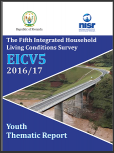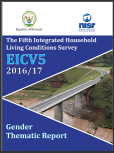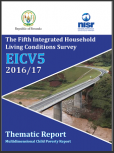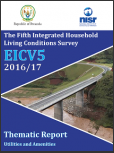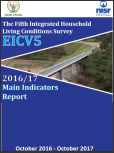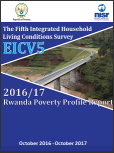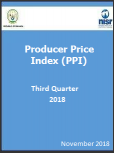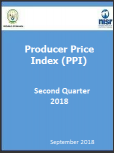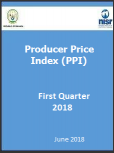EICV5_Thematic Report_Youth
This report presents and discusses detailed results from EICV5. It focuses on youth and compares EICV5 and EICV4 in the areas of demography, education, Information and Communication Technology, economic activity, poverty and migration. Most of tables provide the results on youth population from both EICV5 and EICV4 and help to explore trend over time, as well as different patterns across the provinces, urban and rural areas of Rwanda.
EICV5_Thematic Report_Gender
In this report, the majority of tables provide results for both EICV4 and EICV5 and highlight developments over time, as well as different patterns across provinces in Rwanda, both in urban and rural areas. Emphasis has been placed on including disaggregated results for men and women and male and female-headed households to explore gender-related aspects in key social and economic characteristics of persons and households in Rwanda, as well as other types of disaggregation, such as age group, type of habitat, etc. Where necessary, districts tables have been provided in annex.
EICV5_Thematic Report_Economic activity Thematic Report.pdf
The present report is one of six thematic reports produced from EICV5.
EICV5-Thematic Report-Multidimensional Child Poverty Report
The Multidimensional child poverty analysis, 2016/17 used data from EICV and focused on children aged 5 to 14 and 15 to 17 years. Assessing the current challenges from a child’s point of view offers important insights on the nature of poverty in Rwanda – who are the poor, why their poverty persists, and how poverty is inter-generationally transmitted.
EICV5-Thematic Report-Utilities and Amenities
In this report, the majority of tables provide results both for EICV4 and EICV5, and highlight developments over time, as well as discussing different patterns across the provinces in Rwanda and in urban and rural areas. Emphasis has been placed on including disaggregated results for men and women and male- and female-headed households to explore gender-related aspects in key social and economic characteristics of persons and households in Rwanda, and other disaggregation, such as age group, type of habitat, etc, where necessary.
EICV 5 - Main Indicators Report 2016/17
The Fifth Integrated Household Living Survey (EICV5) was conducted from October 2016 to October 2017, and is designed to provide accurate and up-to-date information that are useful to government, analysts and the public as they seek to monitor and evaluate efforts to reduce poverty.
EICV 5 - Rwanda Poverty Profile Report 2016/17
The Fifth Integrated Household Living Survey (EICV5) was conducted from October 2016 to October 2017, and is designed to provide accurate and up-to-date information that are useful to government, analysts and the public as they seek to monitor and evaluate efforts to reduce poverty.
The data in this report come from the fifth Integrated Living conditions survey (EICV5), which interviewed 14,580 households, representing 64,314 people, throughout the country between late October 2016 and early October 2017.
Producer Price Index Report (Third Quarter 2018)
Rwanda’s general producer price index, combining both prices for local and export products registered an annual decrease of 1.54 percent in the third quarter of 2018 compared with the same period of 2018, while on quarterly basis it decreased by 0.49 percent compared with the second quarter 2018.
Producer Price Index Report (Second Quarter 2018)
Rwanda’s general producer price index, combining both prices for local and export products registered an annual growth of -0.07 percent in the second quarter of 2018 compared with the same period of 2017, while on quarterly basis it decreased by 0.38 percent compared with the first quarter.
Producer Price Index Report (First Quarter 2018)
Rwanda’s general producer price index, combining both prices for local and export products registered an annual growth of 0.27 percent in the first quarter of 2018 compared with the same period of 2017, while on quarterly basis it decreased by 0.58 percent compared with the fourth quarter 2017.

